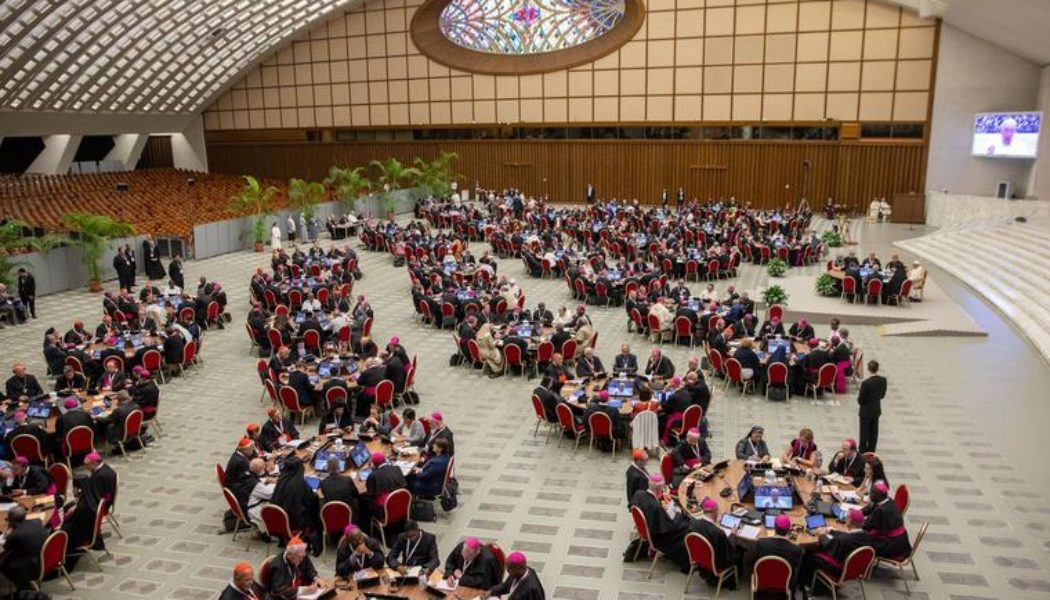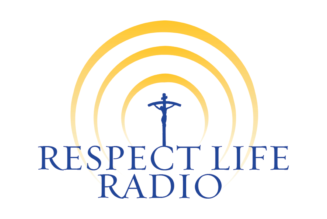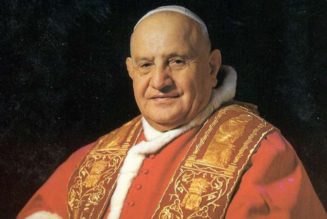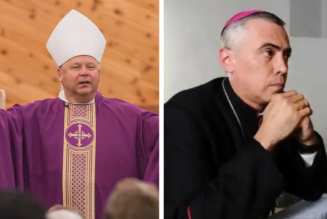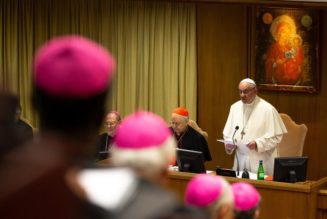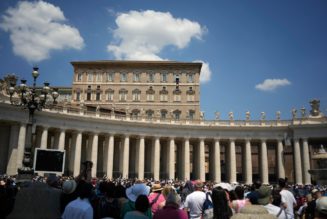
This week and next, the Synod on Synodality is focusing on issues like LGBTQ inclusion and the possibility of opening the diaconate to women — some of the most contentious matters on the gathering’s monthlong agenda.
But contrary to what some may have assumed, not all of the synod’s 364 delegates will have a chance to weigh in on these topics equally. In fact, synod organizers have assigned only some of the members to the small groups discussing these hot-button issues, after members indicated ahead of time what topics they’d prefer to focus on.
It’s a dynamic that could skew the table reports issued on a given topic and, in turn, affect the text summarizing the views of the assembly that will be finalized at the end of the process.
The possibility is a product of the unique way organizers have arranged discussions at this year’s synod.
Unlike previous synods, where members were broken into different language groups but focused on the same topics, the 35 tables in Paul VI Hall for this year’s gathering are divided not just linguistically, but also thematically, for most of the synod’s proceedings.
What this means, in concrete terms, is that while some members have been engaging for the past few days in small-group discussion on the inclusion of LGBTQ-identifying people and remarried divorcees in the life of the Church, others have been focusing on topics like ecumenism and welcoming migrants.
Synod organizers insisted just yesterday that despite the new arrangement, all members will be able contribute on any theme. During set times for “free interventions,” for instance, individuals not assigned to a particular theme will be able to comment on the reports of the groups that are.
“I do believe that everyone has the opportunity to weigh in,” Cardinal Joseph Tobin of Newark, New Jersey, who has been involved in the organization of the Synod on Synodality since 2018, said at a press briefing yesterday.
Cardinal Tobin also added that members were not “frog-marched” into their thematic assignments, but were free to submit their preferences ahead of time, which synod organizers have done their best to honor.
But the concern is less about whether everyone has an opportunity to weigh in, or whether members have been assigned to their top choice, and more about whether the composition of the small groups on a given theme — and the table reports they produce — will accurately reflect the views of the whole assembly.
For instance, a bishop from sub-Saharan Africa may strongly oppose proposals to bless same-sex unions, but he may also view issues like Christian persecution or caring for the poor as greater priorities, given his local context. Under the new methodology at this year’s synod, however, he can participate in a small group focusing on only one of these topics.
The dynamic raises the possibility that the small groups focusing on issues like LGBTQ inclusion and women deacons won’t be reflective of the whole assembly, but will be disproportionately made up of those with the most intense focus on the subject — and the greatest desire to see changes in Church teaching and practice. Focus on these issues tends to be higher in the secular West.
In fact, earlier today, the synod’s spokesman, Paolo Ruffini, shared that some members had asked “for greater discernment on the teaching of the Church on the subject of sexuality,” implying a push for change.
And while synod organizers have attempted to downplay the significance of assigning only certain members to discuss certain topics, they’ve also been unwilling to publicly release a list of who has been assigned to what themes.
Members With Agendas?
Concerns that the arrangement of small groups may allow for skewed results are likely exacerbated by the fact that several participants have indicated their intent to push for changes on hot-button issues at the synod.
For instance, Bishop Franz-Josef Overbeck of Essen, Germany, said that the Synod on Synodality must take up the proposals advanced by the controversial German Synodal Way, “from the role of women to the question of sexuality and the question of people who love each other.” In March, the Synodal Way passed resolutions to bless same-sex unions and push for women’s ordination in Rome.
Regarding the pro-Synodal Way German bishops’ participation in the Synod on Synodality, German Bishops’ Conference president Bishop Georg Bätzing of Limburg said, “We are invited to listen, to speak freely, that’s important, but the aim is also for the Church to change.”
Other synod participants, like the Spanish “TikTok nun” Sister Xiskya Luca Valladares, have supported same-sex blessings in Germany. In an essay on the synod, San Diego Cardinal Robert McElroy said that the Church should downplay “the distinction between orientation and activity” in its pastoral response to LGBTQ-identifying people, while Cardinal Jean-Claude Hollerich, the synod’s relator general, has previously said that the Church’s teaching on homosexuality is “false” and needs a foundational reform. Jesuit Father James Martin, whose approach to pastoral ministry to LGBTQ-identifying people has raised concerns about the subversion of Church teaching, has also stated his intention to focus on LGBTQ inclusion at the synod.
Regarding women’s ordination, the Swiss lay leader Helena Jeppesen-Spuhler has said that “the priesthood of women will not be introduced immediately,” but that the Synod on Synodality could be a stepping stone towards it by first opening the diaconate to women. The Spanish lay theologian Cristina Inoges Sanz, another synod member, is also an advocate for women’s ordination, while Cardinal McElroy has also stated that the Synod on Synodality is the right context for the Church to “move toward admitting women to the diaconate.”
Many had already expressed concerns that these controversial figures are participating in the synod, in most cases not as elected representatives of a bishop’s conference, but as selected by Pope Francis. But with the methodology behind the synod small groups, it seems they may be able to impact proceedings to a greater degree than previously imagined.
A New Methodology
While all members discussed the same topics at their tables during the synod’s opening stage, and will be on the same page again during the assembly’s closing phase, that’s not the case for the substantive middle stretch of the Synod on Synodality.
From Oct. 9 to 21, the assembly’s work is broken into three “modules,” focusing on three broad categories: communion, mission and participation. Each module includes five distinct themes. According to the synod’s regulations, each participant has been assigned to a table that will be “dedicated to the in-depth study” of just one of the five themes considered during each module.
For example, the synod is currently finalizing its work on “Module B1,” on the communion of the Church. Each synod member has been assigned to focus on just one of Module B1’s five themes: justice and charity (B 1.1), inclusion in the Church (B 1.2), Eastern-Western Catholic unity (B 1.3), ecumenism (B 1.4) and interreligious/intercultural dialogue (B 1.5).
Similarly, when the synod begins its work on Module B2 (co-responsibility in mission) and Module B3 (participation, governance and mission), each member will focus on just one of the five themes included in each module.
In the end, each individual synod member will have engaged in “in-depth study” on just three of the 15 themes included in Modules B1, B2 and B3.
Topical worksheets from the synod’s instrumentum laboris (working document) guide these table discussions and also include “discernment questions” on hot-button issues.
Members assigned to B 1.2, for instance, are asked, “In light of the Post-Synodal Apostolic Exhortation Amoris Laetitia, what concrete steps are needed to welcome those who feel excluded from the Church because of their status or sexuality (for example, remarried divorces, people in polygamous marriages, LGBTQ+ people, etc.)?”
Similarly, B 2.3 asks whether “it is possible to envisage” women’s inclusion in the diaconate “and in what way?” In both cases, the way these “discernment questions” have been phrased heightens concerns that the groups addressing them might be stacked with synod participants who have already expressed their support for women’s ordination and changes to Church teaching regarding sexuality.
The small groups will continue to utilize the “conversation in the Spirit” method, which involves guided discussion of the topics at hand, to work through their theme. Following the work of the small groups, there are three “general congregations.” During these three-plus-hour periods, representatives from each table present their initial findings to the whole assembly, followed by time for “free interventions.”
The intent of including free interventions is to allow all members to comment on table reports. But questions remain about whether these periods will allow for members not assigned to a theme to express their views on it in a comparable way.
Additionally, only members of the given working group will be able to vote on approving their table report, which requires a simple majority of the 11 or so members seated at the table to pass. Those reports, in turn, will be submitted to synod organizers, and the recently elected synthesis commission will guide the drafting of summaries of each module, which will be incorporated into a final summative text. It is unclear to what extent interventions will be incorporated into these final reports.
